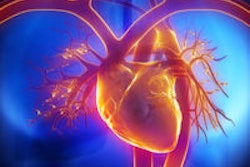
The European Society of Cardiology (ESC) is urging cardiologists to take swift action to reduce radiation doses to patients wherever possible, according to a new position paper published on 8 January by the European Heart Journal.
"A smart cardiologist cannot be afraid of the essential and often life-saving use of medical radiation, but must be very afraid of radiation unawareness," noted Dr. Eugenio Picano from the Institute of Clinical Physiology in Pisa, Italy, and colleagues.
The medical benefits of cardiac imaging are immense, and optimal care requires the use of a variety of techniques, wrote the authors from several European centers. At the same time, however, radiation dose from these tests is high and rising, delivering about 3 mSv per year population-wide, equivalent to 50 chest x-rays per person per year. Cardiology accounts for about 40% of this dose and many exams are inappropriately ordered, they wrote.
The paper asks the cardiology community to both reduce the number of clinically inappropriate exams, and to reduce the doses of those imaging tests that are used appropriately, noting that cardiologists' awareness of radiation dose in the exams they order is still far from where it needs to be.
"The increasing use and complexity of imaging and interventional techniques have not been matched by increasing awareness and knowledge by prescribers and practitioners," the authors wrote. "The majority of doctors -- including cardiologists -- grossly underestimate the radiation doses for most commonly requested tests."
Cardiologists are responsible for much of patients' total radiation dose, and have a particular responsibility to avoid "unjustified and nonoptimized use of radiation," stated the study team.
Based on medical literature, the paper summarizes current knowledge on radiation effective doses and risks commonly used in cardiac exams, which can range from 1 mSv to 60 mSv around a reference dose average of 15 mSv for a percutaneous coronary intervention, a coronary CT angiography (CCTA) exam, or myocardial perfusion scintigraphy.
"We provide a European perspective on the best way to play an active role in implementing into clinical practice the key principle of radiation protection that:'each patient should get the right imaging exam, at the right time, with the right radiation dose,' " the ESC panel wrote.
The authors also stressed the political nature of dose reduction and the economics in imaging decisions. "In these hard economic times, 50% of the costly and risky advanced imaging examinations we do are for inappropriate indications," Picano wrote in a statement accompanying the release of the study. "Politicians' top priority should be to audit and cut down on useless and dangerous examinations."
The risk
Significant increases in the cumulative exposure of patients and population to ionizing radiation "is likely to cause an increased incidence of cancer in years down the line, with an important yet potentially avoidable public health threat," the group wrote. Still, cancer induction is usually not differentiable and traceable to radiation on an individual patient basis, as the cancers take years or even decades to develop.
The way to approach the imaging decision, therefore, is to assess the balance between risks and benefits that determine the appropriateness score of a test. The test is appropriate when the benefits greatly exceed the risks, and inappropriate when risks exceed the benefits, Picano and colleagues wrote.
"The risk-benefit assessment is a 'dynamic,' tailored variable rather than an absolute, fixed concept, since the same test can have a favorable risk-benefit ratio in an individual with intermediate pretest probability and equivocal ECG, and totally inappropriate in a middle-aged woman with atypical chest pain and maximal negative ECG stress test," they wrote.
The first of two principal biological effects of radiation are tissue reactions, known as deterministic effects. Deterministic effects occur when doses exceed a specific threshold and become evident from days to months after exposure as they cause a predictable change in tissue, the authors wrote.
The second risk type is stochastic, of which carcinogenesis is the most serious effect, they wrote. In this scenario, radiation damages the cell's DNA but the cell remains viable, and the harm is eventually expressed through cell proliferation, the authors wrote. Cancer can occur many years after exposure, and reducing this risk is the core of the radiation protection system for patients and staff.
Radiation-induced cancer cannot be distinguished clinically from a spontaneously occurring cancer. For example, out of each 100 individuals exposed to 100 mSv of radiation, 42 will develop a spontaneous cancer that is independent of radiation exposure, the group wrote.
Although nonionizing radiation is generally thought to be safe, the International Agency of Research on Cancer considers the radiofrequency fields used in cardiac MR (CMR) to be a possible carcinogen (class IIb), and the World Health Organization (WHO) has called for urgent action to evaluate possible biological effects of MRI.
BEIR VII report and organ doses
The epidemiological evidence of harm is conclusive only for doses ranging from 50-100 mSv and higher, the group noted. It is for doses below 50 mSv that theories diverge.
For example, the currently accepted linear threshold model of risk directly proportional to the radiation dose. In the supra-linear risk model, the risk of cancer induction is higher for any given dose, and in the hormetic model, low doses may even have a protective effect on health, according to the 2006 report Health Risks from Exposure to Low Levels of Ionizing Radiation: BEIR VII, Phase 218, BEIR VII.
In terms of tissue weighing factors, the highest risks of cancer induction per BEIR VIII are accorded to the breast, colon, lung, stomach, and bone marrow (0.12), the group wrote. High risks are attributed to irradition of the ovaries and testes (0.8). Moderate risks are accorded to the thyroid, bladder, esophagus, and liver (0.04). Low risks are attributable to the bone, salivary glands, skin, and brain (0.01). Very low risks are attributable to the heart, kidneys, pancreas, prostate, and uterus (0.008).
CT use grows, but exam dose falls
In the past two decades, the use of CT for diagnostic uses has increased from 3 million exams in 1980 to almost 70 million in 2007 in the U.S., but at the same time the per-exam dose has fallen dramatically by nearly three-fourths owing to dose-saving scanner technologies.
A calcium scoring exam can be completed using 2-3 mSv, substantially less than most CT coronary angiography (CCTA) exams. But thanks to competition between scanner manufacturers, gated low-dose acquisition of a single frame in end-diastole CCTA on a patient with a slow and regular heart rate can often yield diagnostic images at 1-2 mSv or less.
Interventional cardiology
Fluroscopically guided diagnosis and intervention account for 12% of all exams, but 48% of the total collective dose, Picano and colleagues wrote. Correlation factors between effective dose and dose-area product (DAP) or kerma-area product (KAP) values indicate the total energy delivered to the patient for a procedure, and the dose levels range widely depending on the exam.
The conversion formula from DAP to mSv is age specific, and represents a relevant dosimetry index that should be optimized against diagnostic reference levels for each procedure to comply with the ALARA (As Low As Reasonable Achievable) principle, the authors noted.
"The introduction of nonradiology-based methods of cardiac mapping and the use of coregistration of CT or CMR images of the target structures ... have the potential to drastically reduce these doses," the study team wrote.
Nuclear medicine
In the U.S., nuclear cardiology accounts for half of all nuclear medicine procedures and 85% of the cumulative nuclear medicine dose, as well as 26% of the overall medical exposure.
Dose-reduction strategies include the use of Tc-99m (technetium) sestamibi or tetrofosmin agents as preferred radiopharmaceuticals in SPECT and the use of stress-first/stress-only protocols in patients with low pretest probability of disease.
Using stress first and eliminating rest images can cut the dose by as much as three-fourths, but is rarely used in the U.S. "due to gaps in practitioners' knowledge pertaining to radiation safety," the authors wrote. A lack of knowledge is also responsible for the 15% rate of dual-isotope testing, which delivers an unacceptably high radiation dose of 30 mSv or more.
SPECT detectors with cadmium zinc telluride technology can be used to substantially reduce effective doses and acquisition time for myocardial perfusion SPECT. One goal of providers is to deliver a radiation dose of 9 mSv or less in 50% of studies in 2014.
Protecting providers
Protecting physicians is as important as protecting patients, the writing team stated. This isn't an issue with CT and radiography, but professional exposure can lead to doses as high as 2-5 mSv per year, but more frequently < 1 mSv and < 0.5 mSv among experienced interventional cardiologists and electrophysiologists. This level is still two to three times higher than that of diagnostic radiologists, with a cumulative lifetime risk of about one cancer per 100 practitioners. Adequate radiation protection can reduce the exposure by 90%, Picano and colleagues wrote.
Pediatric cardiology
Risk of cancer induction for some organs is three to four times higher in children than in adults. Their risks are higher because their cells are dividing more rapidly and they have longer life expectancies. And by the age of 15-20 years, congenital heart disease patients have already received 20-40 mSv of cumulative radiation exposure with a corresponding lifetime attributable cancer risk of one in 100 to as high as one in ten patients, the authors noted.
Once again fluoroscopy is key, accounting for 3.5% of all exams but 84% of the total dose. In the U.S., the Image Gently Step Lightly campaign specifically addresses radiation dose in pediatric cardiology.
Women and pregnancy
The cancer risk is higher in women by about 38% compared with men of all ages. The dose to the female gonad should be known and minimized. In an effort to minimize dose, the American Thoracic Society recommended chest radiography as the first radiation-bearing procedure, the use of lung scintigraphy, and the performance of CT pulmonary angiography (4 mSv to 18 mSv) rather than digital subtraction angiography (7-28 mSv).
Pregnant workers may continue to work using radiation protection, with fetal exposure limited to 1 mSv in many European countries and 0.5 mSv in the U.S. for the entire term of pregnancy, Picano et al wrote.
Informed consent should spell out the actual reference dose and store it in the patient's medical record. The provider should explain the dose to the patient in terms of mSv, equivalent chest radiography exams, and time periods of natural background radiation, the group recommended.
"All other considerations being equal, it is not recommended to perform tests involving ionizing radiation when the desired information can be obtained with a nonionizing test with comparable accuracy," Picano et al wrote. "If you perform a test that utilizes ionizing radiation, choose the one with the lowest dose and be aware of the many factors modulating dose."
Include the dose in patient records, the study team advised. In short, when dealing with ionizing radiation, a class I carcinogen, physicians should make every effort to offer the right exam and the right dose to the right patient, they continued.



















